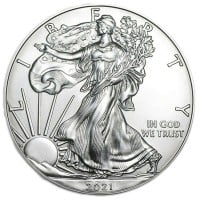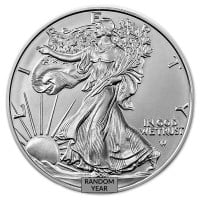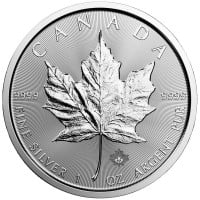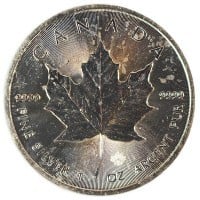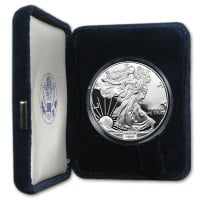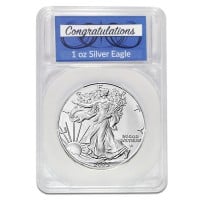Silver coins can make a great long-term investment, provided buyers do not overpay for high-priced and illiquid collectibles. Silver is a great way to truly diversify your portfolio and it offers protection in the event of a financial crisis. And, it is a hedge against the devaluing US dollar. Silver has proven to hold its purchasing power over time.
When it comes to investment-grade bullion (non-collectible) coins, Silver Eagles and Silver Maple Leafs are by far the most popular options. Buyers often ask how to choose one over the other.
The coins are identical in terms of silver content – 1 troy oz – but there are differences to consider. Besides the different designs featured on the coins, other subtle features can affect the value, and thus the desirability, of each.
We will cover the similarities and differences between the Silver Eagles vs. Maple Leafs below.
Canadian Silver Maple Leaf vs Silver Eagle Coins – Similarities
Both the Eagle and the Maple Leaf are sovereign coins. They are issued by the US and Canadian governments and are guaranteed for weight and purity. Both are also legal tender, and counterfeit laws apply. The trust and assurance that comes with being a sovereign issue make them desirable to many silver stackers and investors.
The premium or amount buyers pay above the melt value of silver to purchase, associated with each coin, has been relatively stable and predictable. For most of the past 10 years, the coins have been priced between $2 - $4 over the silver market price.
Each coin weighs around 31.1 grams or one troy ounce. The silver content is 99.9% for the Silver Eagle and 99.99% for the Silver Maple Leaf.
Like all coins, these coins have a nominal face value.
The Silver Eagle has a symbolic nominal value of US $1 – which technically makes it a silver dollar. However, coin industry people do not use the term silver dollar to refer to the Silver Eagles. Instead, the silver dollar is a generic name for older silver coins that came into circulation between 1878-1935. So, to avoid confusion it is best to call them by their actual name – Silver Eagle.
The Silver Maple Leaf has a nominal face value of Can $5, a much higher face value than the Silver Eagle. But face value is almost irrelevant. It’s the commodity price of silver and the desirability of each coin that determine its actual value. Current silver prices make the true value of each coin multiples of its face value.
Silver Eagles and Maple Leafs come from the mint in similar packaging. Mint boxes contain 500 coins. The Eagle mint boxes contain 25 tubes filled with 20 coins each. The Maple mint box contains 20 tubes of 25 coins each. Both boxes are designed to be stackable.
Silvers Eagles vs. Maple Leafs – Differences
These coins belong to the same general category of bullion products, but there are a few differences to consider. These differences will matter more to some investors than others, so it behooves cautious investors to understand the variations.
The first batch of Silver Eagles came out of the US Mint in 1986. The Royal Canadian Mint, on the other hand, introduced the Silver Maple Leaf a couple of years later.
Over the years the US Mint has churned out many more coins to meet the demand. The Eagle is the most popular bullion coin in the world.
To put things into perspective, by now there are more than 400 million Silver Eagle coins in circulation. Perhaps half as many Silver Maple Leaf coins have been issued. Because of the numbers issued, neither coin is likely to become collectible.
Silver Maple Leafs are often $.50 - $.75 per ounce cheaper. But that doesn’t mean that Silver Maple Leafs are not a good investment. Quite the contrary. Some collectors believe Maple Leafs will perform better in the long run, because the acquisition price is a bit lower.
The purity of the Silver Maple Leaf is .9999, and it is .999 for the Silver Eagle. While the intrinsic value which comes from having the higher purity is negligible, there are many investors who feel higher purity is better.
Silver Eagles vs Maple Leafs – Which One to Buy
Buyers really can’t go wrong when purchasing either of these coins. Both coins offer good value and are highly liquid. Every precious metals dealer in the country is happy to either buy or sell these coins at a moment's notice and prices tend to be very competitive. While Silver Eagles cost a bit more to purchase, they also bring a bit more when it is time to sell.
Buyers whose focus is on buying as many ounces of silver as possible for the amount they plan to spend should favor the Maple Leaf. Those looking for the most popular and widely traded coin, and those who prefer US legal tender coins, will want the Silver American Eagle.
Conclusion
Investing in silver coins is one of the best ways to secure your future. Besides the opportunity to generate investment returns, these coins are also beautiful. They are tangible and hold value independent of what is happening on Wall Street and in the global financial system, unlike conventional “paper” investments such as stocks or bonds. We hope this outline of similarities and differences will help investors choose. However, for those who still struggle to decide, there is nothing wrong with investing in both!

About the Author:
Clint Siegner is a Director at Money Metals Exchange, a precious metals dealer recently named "Best in the USA" by an independent global ratings group. A graduate of Linfield College in Oregon, Siegner puts his experience in business management along with his passion for personal liberty, limited government, and honest money into the development of Money Metals' brand and reach. This includes writing extensively on the bullion markets and their intersection with policy and world affairs.





